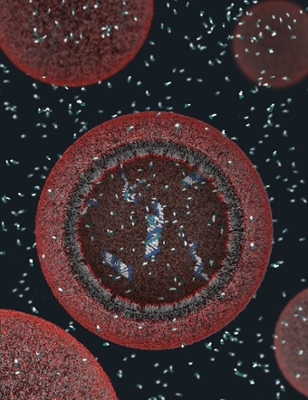Drawing pictures. As simplistic and unscientific as it sounds, pictures have been one of the most powerful tools scientists have used to help them understand and explain the unknown. Today, the rough sketches of centuries past have given way to elaborate computer animations that are helping researchers understand the inner workings of some of the most mysterious and miniscule science there is—that of cell processes deep within our bodies.
Molecules in Motion fill in the blanks for AIDS Research
Molecular animators, today’s imaging pioneers, are literally making movies starring cells, proteins, molecules, viruses and more. Using the same software that creates Hollywood blockbusters, these scientist-filmmakers believe their animations have the potential to change the way we think about biology—serving both as a processing tool for scientists as well as an outreach tool to explain science that otherwise would be too abstract or intimidating in its complexity.
"All that we had before—microscopy, X-ray crystallography—were all snapshots," commented Harvard biology professor Tomas Kirchhausen, Ph.D., in an article in The New York Times entitled, "Where Cinema and Biology Meet." "By doing animation I can see what makes sense, what doesn’t make sense," said Kirchhausen, who studies the process by which cells engulf proteins and other molecules. "[Animations] force us to confront whether what we are doing is realistic or not."
This animation shows endocytosis, a process by which a cell is able to internalize molecules on its surface.
Animations aren’t created just to showcase what works, but also to help scientists better understand why their hypotheses may not work. "My animations always include a number of ideas, some of which may be backed by a great deal of experimental data, and some that are more conjecture," says University of Utah researcher Janet Iwasa, Ph.D., who is collaborating with top researchers across the United States to create a comprehensive molecular animation model for the AIDS virus. While much has been discovered about AIDS in the last 30 years, Iwasa points out that, on a molecular level, there’s still a lot that remains unknown.
"There’s not a lot of animation that accurately captures the molecular details known about the lifecycle of HIV," says Iwasa, who works with researchers focused on understanding structural aspects of HIV trafficking and assembly. “We believe that these visualizations will serve as powerful thinking models for the HIV research community.”
The structure of HIV and its entry into an immune cell are depicted in this animation, which Iwasa has described as a work-in-progress.
Visual Representations Spark Scientific Discussions
The very process of putting together a visual puzzle, especially something as ambitious as a model of the AIDS virus, often sparks discussion and disagreement, and raises important questions that scientists have not yet explored. For example, what are the relative sizes and shapes of interacting proteins? How do they fit together as a complex in three dimensions? What is the timing of those interactions and how quickly do they come apart? Those questions often give researchers ideas about what experiments still need to be done. "In the end, we’ll have a wonderful animation piece that encompasses everything that’s historically known about HIV entry and egress as well as new research."
Across campus, at the Scientific Computing and Imaging Institute, Iwasa’s colleague Miriah Meyer, Ph.D., is asking equally probing questions to create a different kind of computer visualization. Meyer uses her expertise in computer science to visually organize and interpret complex data sets from scientists, including genomic data sets. "I find that just by asking questions, my collaborators often confront unexpected assumptions and limitations," says Meyer, who along with Iwasa, was included in Fast Company’s 100 most Creative People in Business. "There’s something powerful about having to clearly articulate data analysis needs."
Beyond Science: Art with a Purpose
In addition to being useful, these fantastical animations and visualizations are also appreciated as works of art, displayed in museums and galleries across the country. "Art exhibits can be an unintimidating way to get people to see, think and talk about science in a public setting" says Iwasa, whose first animation project Exploring Life’s Origins was displayed at the Museum of Science in Boston.
Iwasa is quick to counter skeptics who view animation as more Pixar-style "eye candy" than hard-core science. "Animation allows scientists to envision a hypothesis and come up with new ideas based on what they are seeing," says Iwasa. And isn’t that, after all, a lot like drawing pictures.
Allowing scientists to create, visualize, modify and share their hypotheses around molecular movement will speed the discovery process, Iwasa says in a recent talk at TED 2014 in Vancouver. Read the full TED Q&A with Iwasa and watch the video on the TED site.
Peta Owens-Liston is a communications specialist for ARUP Laboratories